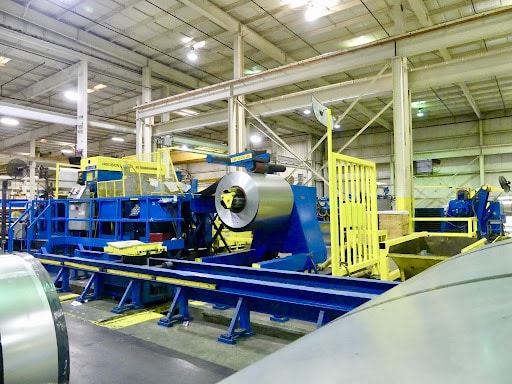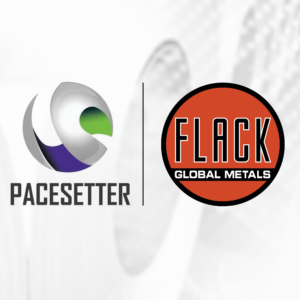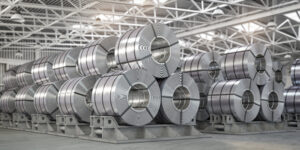Steel Blanking Processing Services
We provide comprehensive steel processing services using advanced technology and world-class technicians at our steel service centers. We offer a variety of types of steels that come in several finishing styles, including:
In addition, many of our clients also want their steel processed in various ways, including cut to a specific length, toll processing, slitted to a specific dimension, and also, blanked. What exactly is a steel blank and why is it so useful to a variety of industries? Let’s discuss steel blank processing, the benefits, and common applications.
What is Steel Blanking?
Steel Blanking is a type of manufacturing process. Technicians employ a stamping process to punch out circular pieces of steel (or “blanks”) from sheet metal. Steel blanks are then cut to specific lengths and stamped into a specific shape by die sets. Steel blanking is usually done on thin sheet materials. Steel Blanking machinery can process a variety of thickness ranging from 0.13mm to 6mm, but it’s usually done on thin sheet materials. We can process multiple sheets at a time but the steel sheets will require additional work to create a smooth finish.
The Pacesetter difference is that our precision blanking equipment produces highly tolerant blanks of +/- .005” for width and +/- 0.015″ in length. We also use corrective levelers to stretch the material and remove residual stresses. If requested, we can also apply a strippable, protective film and oil your steel blanks.
How Steel Blanking is Different From Other Processes
Slitting and cut-to-length processing are different from blanking because they both do not actually remove steel from the original sheet. Punching, on the other hand, is often confused with blanking. The difference between blanking and punching is what part of the processed sheet is the final product.
When a large sheet metal is processed and punched out, circles of steel are produced, the steel circles are the final product and the remaining sheet is scraped. Punching, on the other hand, is the opposite. The steel circles are scraped and the final product is the original sheet of metal with holes in the surface.
Steel Blanking Benefits and Common Industries Served
Steel blanking is a fast and efficient process and once our technicians set your preferred specifications, we can execute high-output production for fast turnaround. All it takes is placing metal steel sheets into the blanking machine to produce consistent blanks with strict tolerances.
Also, our team can reuse the primary metal sheet stock to reduce waste and make more with less. We will set the nest parts as close as possible to improve yield and send you only the blanks you need to reduce shipping and production costs.
Since technicians can fit blanks to meet customized specifications, a variety of industrial industries can utilize the service for their projects. Aerospace, automobile, and household appliance manufacturers are three of the biggest industries that rely and benefit from steel blank production. Since steel processors like Pacesetter can produce holes in various shapes and we can control the quality of punch and die clearance for our clients, industries besides the ones mentioned above can benefit from steel blank processing service lines.
Other Popular Steel Blank Applications
Steel blanks come in many forms and serve a variety of applications. Here are some of the most-searched steel blank types and how they are used:
Damascus Steel Knife Blanks
Think of a knife blank as the base of a knife. Before adding a polished wooden handle, a knife blank is the complete steel frame of the knife. Professional and amateur knifemakers rely on knife blanks to create a variety of knives, including hunting, folding, and kitchen knives. Artisan knife makers often will purchase knife blanks rather than a sheet of steel to lower production costs.
They can purchase a range of knife blank designs, including dagger, skinning, or fixed blades. In addition, knife blanks come in a variety of materials, including stainless and carbon steel. One of the most premium and sought-after steel knife blanks are made of Damascus steel.
Damascus steel is created using an ancient technique European and Japanese sword makers used to make stronger and more flexible blades. They are composed of several different metals which give the blades their beautiful and unique pattern.
Often, the blades are heat-treated and pre-sharpened but owners should be careful of what their blade is exposed to because it can easily rust. For instance, a leather sheath will corrode damascus steel due to the moisture. Knife owners should apply protective oil on the edge of their blades to help maintain pristine condition.
Pattern Welded Steel Blanks
Pattern-welded steel leverages several different kinds of metals and by forging them together, the welded steel has its own distinct pattern shape. Japanese sword makers, and even Vikings, used this ancient technique for reasons besides an aesthetic appeal.
In fact, Japanese sword makers would often use leftover steel along with iron and other metals to produce more blades. However, combining several different metals allows the blades to adopt the best qualities of each material once it is forged together.
Although damascus steel is often confused with pattern-welded steel, there are some distinct differences. Authentic damascus steel has a very specific casting processing that utilizes high carbon steel. Craftsmen treat the steel near fusion temperatures for extended periods of time which creates large dendrites on the material. True damascus steel requires no welding and uses a specific forging method using Wootz steel.
Metalworkers use several layers of steel sheets and apply heat and pressure to bond the materials together. As they fold the welded steel over and over again, swirling layers form which gives pattern-welded steel its distinctive appearance. Pattern-welded steel has many advantages, including:
- Extreme durability
- Flexible yet resistant to shattering
- Can be sharpened into an extremely fine blade
- Rust resistant
Carbon Steel Knife Blanks
Carbon steel is one of the most popular materials to produce kitchen and other types of knives. High carbon steel is praised for its durability and ability to hold a sharp edge. However, it can stain easily and is susceptible to rust. It also takes regular cleaning with stainless steel pads to maintain a pristine appearance.
Many knife manufacturers prefer to work with high carbon stainless steel since it has high durability, maintains sharpness, but also is more stain-resistant than regular carbon steel knives.
Carbon steel is available in three categories, each with their own unique properties:
- Low-carbon steel (< 0.25 wt. carbon %) has high ductility and low hardness. It is often used to create automobile parts, pipes, construction material, and cans.
- Medium-carbon steel (0.25 – 0.60 wt. carbon %) has medium ductility and hardness. It is often used in more industrial applications, ushc as railway tracks, crankshafts, and machinery parts.
- High-carbon steel (0.60 – 1.25 wt. carbon %) is extremely hard with low ductility. It is used for cutting tools, sprins, and wires.
High Speed Steel Blanks
High-Speed Steel (HSS) is a high-carbon steel containing tungsten, molybdenum, chromium, vanadium, and cobalt. The high-alloy steel mainly has tungsten or molybdenum with a high carbon content of at least 0.65% weight. The unique heat treatment process gives the metal it’s hardness and resistance.
Depending on the specific properties within the HSS, it is assigned specific grades. Depending on the application, HSS can incorporate various alloying elements to give a desired property. For instance, adding more cobalt improves hot hardness but it becomes more susceptible to brittleness.
HSS is commonly used for industrial applications, such as tool bits, milling cutters, drills, or saw blades. In addition, high-speed steel may be used to create a variety of hand tools, such as chisels or pocket knives.
Contact Us for Your Steel Blank Processing Needs!
Send us a message to learn about how we can handle your steel blank processing requirements. In addition to blanking and multi-blanking, we also provide slitting and cut-to-length services. If you have your own steel, we also offer toll processing. If not, we can supply you with a variety of steel types to fit your needs, including:
- Cold-rolled steel
- Aluminized steel
- Stainless steel
- Galvanized steel
- Galvanneal steel
- Bonderized steel
We pride ourselves on high-speed precision capabilities, fast turnaround times, and efficient shipping to keep your costs down. Learn more about our philosophy and request a quote, today!




